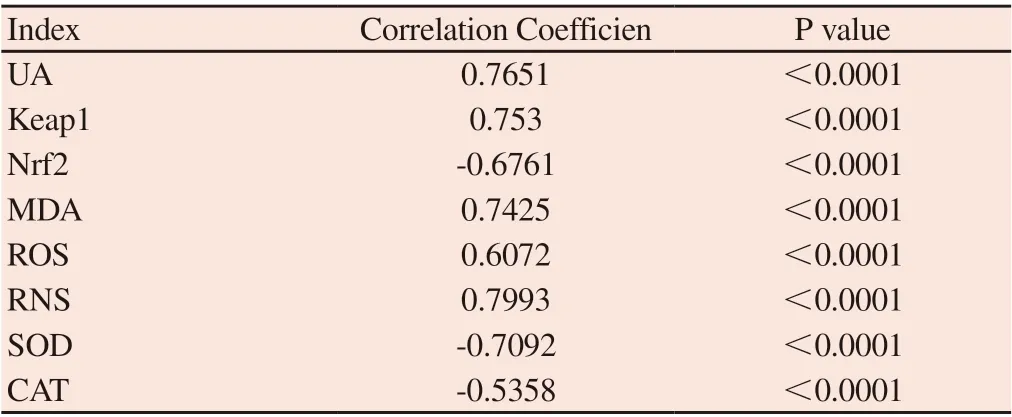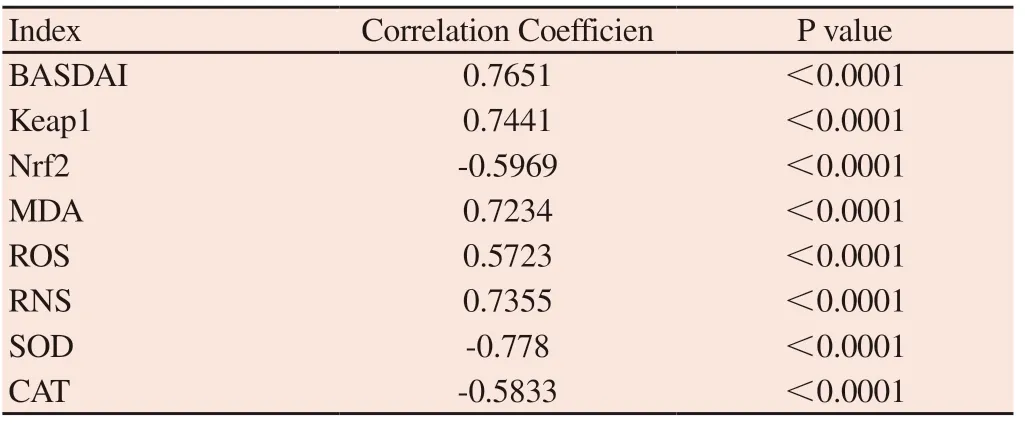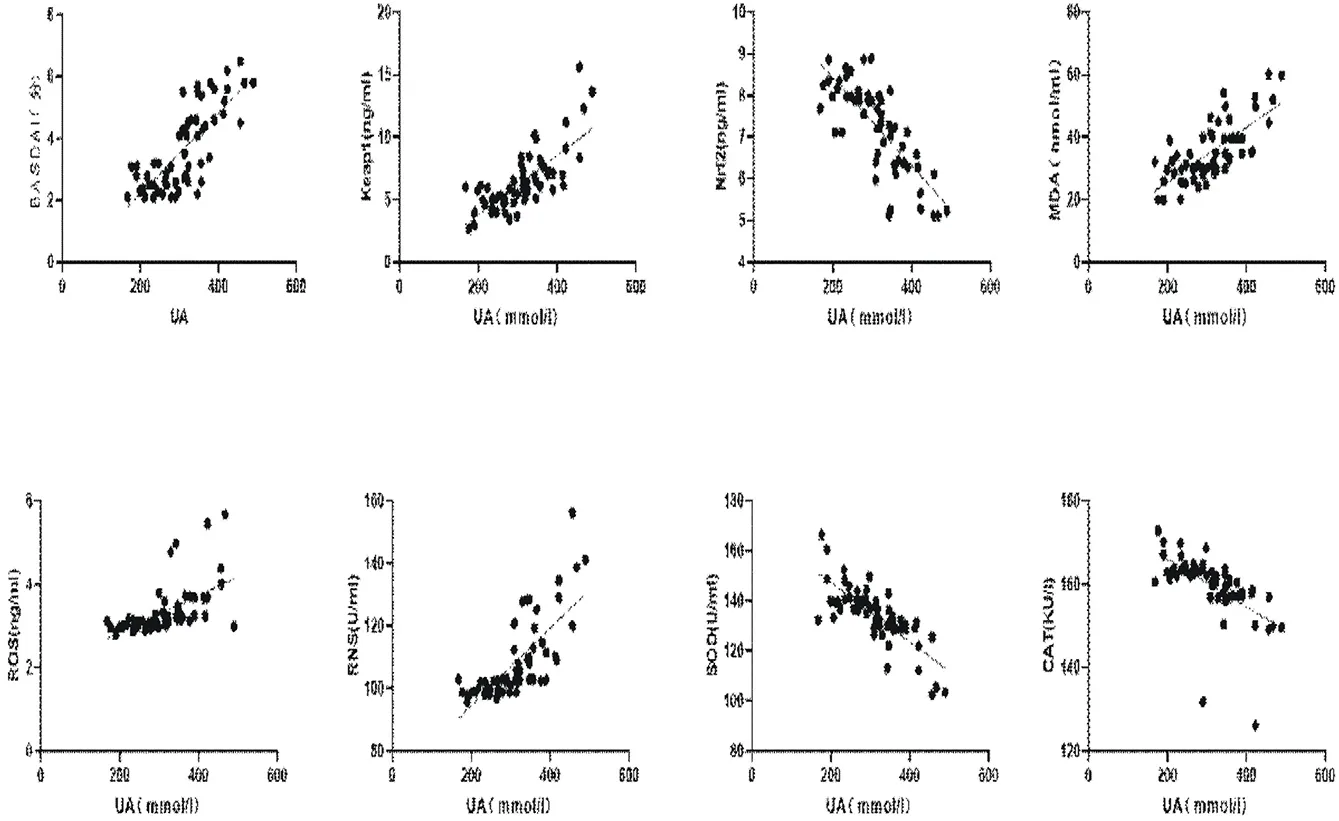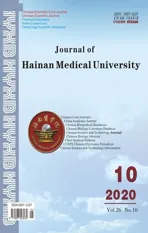The effect of plasma uric acid on oxidative stress in ankylosing spondylitis by Keap1-Nrf2 signaling pathway
2020-07-23RuiMingShenGuoQuanLiFengGuo
Rui-Ming Shen, Guo-Quan Li, Feng Guo
Department of Rheumatology, The First affiliated hospital of Hainan medical university, Haikou, 570102, China
Keywords:
ABSTRACT
1. Introduction
Ankylosing spondylitis is a chronic inflammatory disease with unknown etiology, mainly involving spine and sacroiliac joint [1]. Recent studies have shown that the oxidative stress level of AS patients has increased significantly [1, 2]. The Keap1-Nrf2 signaling pathway plays a vital role in reducing the damage of oxidative stress to the body [3, 4]. Serum uric acid is the end product of purine metabolism in human body. Studies have confirmed that the continuous high expression of UA in AS patients can initiate oxidative stress, thus aggravating AS inflammatory reaction [5, 6], but whether UA plays a role in AS through Keap1-Nrf2 signaling pathway has not been reported. In this study, UA, Keap1, Nrf2 and oxidative stress indexes of AS patients were detected to explore the mechanism of UA on oxidative stress of ankylosing spondylitis (AS) through Keap1-Nrf2 signaling pathway.
2. Patients and methods
2.1 Patients
60 AS patients admitted to our hospital from March 2018 to October 2019 were selected as research objects. Inclusion criteria: age ≥ 18 years old, meeting AS New York classification criteria, and all have signed informed consent forms.
2.2 Methods
2.2.1 Collection and storage of blood samples after admission
3ml venous blood was collected on an empty stomach from AS patients, centrifuged at 3000 r/min for 15 min in a centrifuge, and the supernatant was sucked and frozen in a refrigerator at-80 ℃.
2.2.2 Methods
All samples were remelted at normal temperature, and the contents of Keap1, Nrf2, CAT, SOD, MDA, RNS and ROS in patients' serum were detected by ELISA. Keap1, Nrf2 kits were purchased from Abcam (Shanghai) Trading Co., Ltd., SOD, CAT, MDA, RNS and ROS kits were purchased from Nanjing Jiancheng Bioengineering Research Institute, and the samples were detected according to the kit instructions. Erythrocyte sedimenta-tion rate (ESR) was detected by Widmann method. The expressions of uric acid (UA) and C-reactive protein (CRP) in blood were detected by Hitachi 7060 automatic biochemical analyzer. According to BASDAI score, AS patients were divided into disease active group (BASDAI ≥ 4), Group A) and disease inactive group (BASDAI < 4,Group B) were used to analyze the relationship between UA, BASDAI and oxidative stress.
2.3 Statistical analysis
The statistical processing was analyzed by SPSS 22.0 software, and the measurement data (x±s) were expressed. The average number between groups was compared by t test, and the correlation between the two indexes was analyzed by Pearson correlation analysis.When P < 0.05,the difference was statistically significant.
3. Results
3.1 The expression levels of ESR, CRP, UA, ROS, RNS, MDA
Keap1 in AS disease active group were significantly higher than those in AS disease inactive group (P < 0.001); The levels of Nrf2, CAT and SOD in the active group of AS disease were significantly lower than those in the inactive group of AS disease (P < 0.001).

Table 1 Comparison of ESR, CRP, UA, ROS, RNS, MDA, CAT, SOD, Keap1 and Nrf2 expressions between AS disease active group and AS disease inactive group

Fig.1 Comparison of expression of ESR, CRP, UA, ROS, RNS, MDA, CAT, SOD, Keap1, Nrf2 between AS disease active group and AS disease inactive group (x±s)
3.2 Pearson correlation analysis
ROS, RNS, MDA and Keap1 in patients with ankylosing spondylitis were positively correlated with blood UA and BASDAI (P < 0.001), while Nrf2, CAT and SOD were negatively correlated with blood UA and BASDAI (P < 0.001), and blood UA was positively correlated with BASDAI (P < 0.001).

Table 2 Correlation Analysis of Serum Uric Acid, Oxidative Stress Indexes and BASDAI in Patients with AS

Fig.2 Correlation analysis of blood uric acid, oxidative stress index and BASDAI in AS patients scatter plot

Table 3 Correlation Analysis of BASDAI, Oxidative Stress Indexes and Serum Uric Acid in AS Patients

Fig.3 Correlation Analysis of BASDAI, Oxidative Stress Index and Serum Uric Acid in AS Patients Scatter Diagram
4.Discussion
The pathogenesis of AS is still unclear, which may be related to genetic, inflammatory, immune and environmental factors. Recent studies have shown that oxidative stress plays a vital role in the occurrence and development of AS [6, 7]. Oxidative stress refers to the excessive oxidative stress that occurs when the body suffers from various harmful stimuli, resulting in oxidative damage to lipids, proteins and other substances, and eventually tissue and organ damage [8].
Chronic inflammatory joint diseases such as rheumatoid arthritis and AS have severe oxidative stress. Studies have shown that AS patients can produce a large amount of oxidative active substances, activate oxidative stress reactions and cause tissue damage [7]. Dong et al. [9] found that the oxidation index of AS mice is higher than that of healthy mice, while the antioxidation index is lower than that of healthy mice. Ozgocmen et al. [10] found that MDA level and CAT activity in blood of AS patients were significantly higher than those of normal control group in active phase. Recent studies have shown that oxidative stress plays a key pathogenic role in AS [7, 11]. Karakoc et al. [1] found that the total oxidative state and oxidative stress index of AS patients are higher than those of the control group. Yazici et al. [12] found that BASDAI is positively correlated with ESR and CRP in patients with active AS. The results of this study showed that the expre-ssions of oxidative indexes such as ROS, RNS and MDA in AS patients were significantly increased, while the expressions of antioxidant indexes such as CAT and SOD were significantly decreased. ROS, RNS and MDA were posi-tively correlated with BASDAI (P < 0.001), while CAT, SOD were negatively correlateed with BASDAI (P < 0.001), which indicated that AS patients had oxidative stress imbalance. Keap1-Nrf2 signaling pathway is an effective antioxidant regu-latory pathway in the body and plays a vital role in alleviating oxidative stress damage in the body [13-15]. The results of this study showed that the level of Keap1 and Nrf2 in the active group of AS disease was higher than that in the inactive group of AS disease, while the level of Nrf2 was significantly lower than that in the inactive group of AS disease (P < 0.001), suggesting that Keap1-Nrf2 signaling pathway was involved in the imbalance of oxidative stress in AS.
UA is the final product of purine metabolism and is closely related to the life activities of organisms. UA is a double-edged sword. It can be used as an important antioxidant in the body, scavenging water-soluble free radicals in plasma, and can also be used as an oxidant. Uric acid can promote lipid peroxidation, generate intracellular oxides by activating NADPH oxidase-dependent pathways, and promote oxidative stress and inflammatory reactions [16, 17]. The results of Pearson correlation analysis showed that ROS, RNS, MDA, Keap1 were positively correlated with blood UA, while Nrf2, CAT, SOD were negatively correlated with blood UA, and blood UA was positively correlated with BASDAI (P < 0.001). The mechanism may be that blood UA produces intracellular oxides by activating NADPH oxidase-dependent pathway, which leads to the increase of ROS, RNS and MDA levels and promotes the expression of Keap1, while the combination of Keap1 and Nrf2 leads to reduced expression levels of Nrf2, These indicate Keap1-Nrf2 signaling pathway is inhibited, antioxidant capacity is decreased,so inflammatory response increase in patients with AS.
In a word, this study shows that blood UA participates in the progress of AS and has a certain correlation with the degree of AS disease activity. The possible mechanism is that blood UA inhibits Keap1-Nrf2 signaling pathway, which leads to the weakening of antioxidant reaction and further aggravates the occurrence of inflammation. Therefore, controlling blood UA level is helpful to control the progress of AS, but its exact mechanism needs further study.
杂志排行
Journal of Hainan Medical College的其它文章
- Discussion on application of food-medicine homologous traditional Chinese medicine in prevention prescriptions for Coronavirus Disease 2019 (COVID-19)
- miR-146a-3p targeted RELB to regulate cytokine secretion in endothelial cells of atherosclerotic mice
- Expression and mechanism of miR-122 in rats with acute myocardial infarction
- The influence of vitamin D3 on airway inflammation and osteopontin expression in cough variant asthma rats
- Differential expression and function prediction of miRNAs in Hepatocellular carcinoma based on bioinformatics
- LINC01614 expression in gastric cancer and its prognostic value based on bioinformatics analyses
